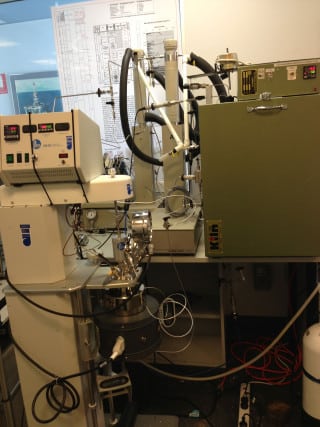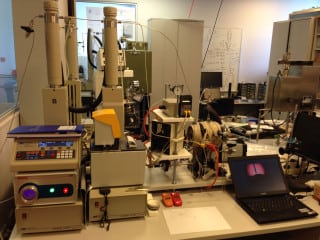Reservoir wettability laboratory
Rock wettability is one of the fundamental parameters determining dynamic and static fluid behaviour in a reservoir. Wettability therefore directly impacts on hydrocarbon production and CO2 geo-sequestration (CCS) efficiency. We study this parameter using a combination of experimental and computational methods.
For the experimental arm of our investigations we commissioned the reservoir wettability laboratory, which includes following facilities:
Core-flood apparatus (centimetre scale)

We have commissioned a core-flood apparatus, which was specifically designed for capillary pressure measurements at reservoir conditions. Our studies currently focus on CO2 behaviour, as the static behaviour of CO2 in rock at CCS conditions is not well understood. Here we investigate core plugs with typical dimensions (38 mm diameter, 50-300 mm length). Check our publication lists for results.
Contact angle and interfacial tension measurement apparatus

We have commissioned an apparatus with which we can measure interfacial tensions between reservoir fluids and contact angles such fluids form with a rock surface. These measurements are also conducted at reservoir conditions (i.e. high pressure, elevated temperature) to mimic true engineering conditions.
It is important to match real conditions as that can have a profound impact on the physico-chemical behaviour of the fluid-fluid and fluid-fluid-rock systems as we have shown theoretically using a Molecular Dynamics approach.
A micro-computed tomograph (nanometre to centimetre scale)
The Micro CT scanner forms part of the National Geosequestration Laboratory (NGL), a research and development facility established to develop innovative solutions to minimise risk and uncertainty associated with the geological storage of carbon dioxide. The facility is a collaboration between Curtin, CSIRO and UWA, and build on the successes of the Western Australian Energy Research Alliance (WA:ERA). The NGL is funded by the Department of Industry, Innovation, Climate Change, Science, Research and Tertiary Education, to the value of $48.4 million.
We investigate wettability characteristics of different rock-fluid-fluid systems by imaging their distribution in the pore space of the rock. The detailed configuration of the fluids is a function of the rock’s wettability and therefore a measure of wettability.